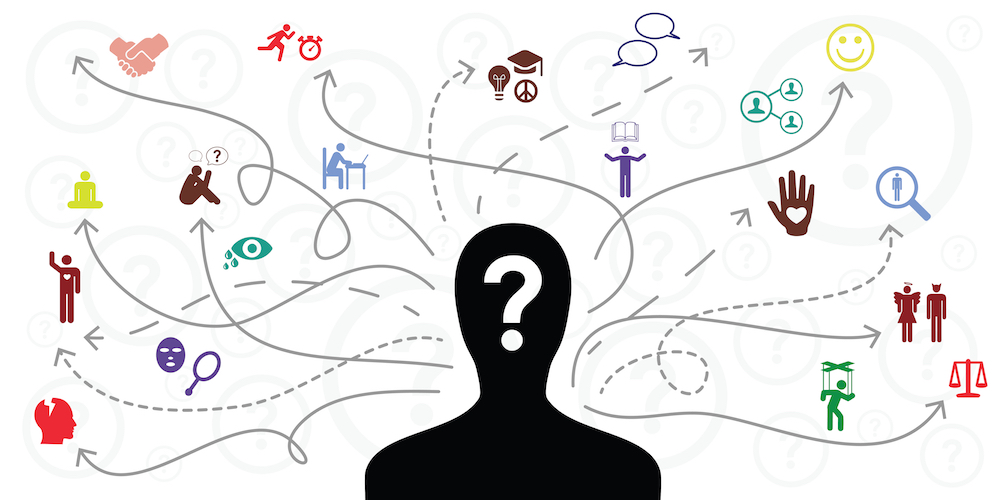Chapter 03: Ideate
In this chapter:
Ideation means generating lots of ideas. Design thinkers use divergent and convergent thinking to come up with fresh solutions. After brainstorming to generate many options and ideas (divergence), you will need to rank, sort, combine, and select the best of them (convergence) for further development.
Divergent Thinking
Whether working in a group or as a design thinking team of one, ideation is a valuable activity to step beyond obvious solutions. Design thinkers practice ideation to create fluency (volume) and flexibility (variety) in our innovation options.

The ultimate goal of divergent thinking (also known as brainstorming) is to create new solutions for the problems you want to solve. The immediate goal is to multiply your insights and ideas. Insights become valuable when you can act on them as inspiring opportunities. To get there, turn your insights into brainstorming questions, the springboard for your ideas.
You can use brainstorming to find out what you already know about your design challenge — and to identify what else you’d like to learn about it. Brainstorming encourages you to think expansively and without constraints. It’s often the wild ideas that spark visionary thoughts.Brainstorming may often be thought of as wild and unstructured, but it in fact is a focused activity that involves a lot of discipline. With careful preparation and a clear set of rules, a brainstorm session can yield hundreds of fresh ideas.
Here are some tips to kickstart your brainstorming work:
Start with a well-defined topic. Think about what you want to get out of the session and stay focused on your topic.
Aim for quantity to reach quality. More ideas means more opportunities for a great solution to emerge. Set an outrageous goal for the number of ideas you want to generate—then surpass it. The best way to find one good idea is to come up with lots of ideas.
Expand your ideas to further develop them by asking:
- Who can use this and what problem does it solve?
- Where and when will this be used?
- How can I improve this idea?
- What do I need to make this idea work?
Develop “how might we” questions. Evolve your ideas by asking “How might we…?” or “What if…?” questions about each of them. This will encourage you to imagine avenues for further exploration, and to come up with plans to work around constraints you might be facing.
Choose brainstorm questions. Select three to five questions for your brainstorm session. Trust your gut feeling: choose those questions that feel exciting and help you think of ideas right away. Also, select the questions that are most important to address, even if they feel difficult to solve for.
Defer judgement. There are no bad ideas at this point. There will be plenty of time to narrow them down later, during the convergence phase.
Generate unusual, even “wild” ideas. When brainstorming, analogous inspiration is your best friend. Bring in random influences to help spark new thinking. Even if some of your ideas seem silly or impossible, this is the time when you can use your imagination.
Be visual and “sketch to think”. Sketching even a simple representation of an idea makes you think through a lot of details. Stick figures, mind maps, and simple sketches can say more than many words. Brainstorm ways to bring your concept to life early to figure out how you might take an idea further. Draw your ideas, as opposed to just writing them down.
Convergent Thinking
Convergence is fundamentally about arriving at conclusions by making connections, or synthesizing data, ideas, and insights. Put differently, it’s about connecting the dots. “Synthesis, the act of extracting meaningful patterns from masses of raw information, is a fundamentally creative act,” explains Tim Brown, “the data are just that—data—and the facts never speak for themselves.”[1]

To practice convergent thinking, here are some steps to follow:
Pattern quest. Cluster related ideas. Spend a few minutes immediately after a brainstorming session grouping together similar ideas into categories or buckets. Step back and identify important patterns that have emerged in your data. Try to find overlaps, themes, contradictions and tensions as they relate to each other.
Grow an idea. Mix and match elements of ideas to create even better ones. By remixing and combining ideas, whether good or bad, feasible or infeasible, you will generate new ones.
Narrow the set. So far, you have (hopefully) been developing your idea without giving much thought to the constraints you may face while attempting to realize it. It makes sense to now do a reality check: look at what’s most important about your idea and find ways to evolve and develop it further. Now is the time for evaluation. Decide what makes some of your ideas more achievable than others. Look at all of the ideas you have generated, then decide which you want to try to build and test first.
List constraints. Make a list of all the challenges and barriers you are facing with your idea. What are you missing? Who would oppose the idea? What will be most difficult to overcome? Brainstorm how you might address some of these challenges.
Archive ideas. Let go of ideas that feel too difficult to create, or that you are not excited about. Keep your Post-its and notes so you can revisit them later.
Suggested Deliverables for the Ideation Stage:
You may want to visualize your research and design work using the following graphic organizers:
- Mind map
- Mood board
- Collage
- Business model canvas
- Service blueprint
- Value proposition canvas
Final Thoughts
To sum up, in this chapter we’ve covered the process of idea generation. Mentally, the ideation stage of the design thinking method represents a process of “going wide” in terms of concepts and outcomes. Ideation provides the fuel for building prototypes and driving innovative solutions.
Attributions: material from the following open source texts was adapted and integrated into this chapter
“Design Thinking for Educators” IDEO. Circa 2013. CC BY-NC-SA 3.0 https://designthinkingforeducators.com/toolkit/
“Collective Action Toolkit” Frog Design. Circa 2016. CC-BY-NC-SA 4.0 https://www.frogdesign.com/wp-content/uploads/2016/03/CAT_2.0_English.pdf
“Design Thinking for 11th Graders” Bridget McGraw. Circa 2016. CC BY-NC-SA 3.0 http://www.open.edu/openlearn/science-maths-technology/engineering-andtechnology/design-and-innovation/design/design-thinking/content-section-0
“The K12 Lab Network wiki” Circa 2015. CC BY-NC-SA 3.0 https://dschool-old.stanford.edu/groups/k12/
- Tim Brown. "Change by Design" 2011. Wiley Online Library ↵
